index memoir - homepage - contact me at
The removers came and we sadly packed up at Groenenborgerlaan, in Wilrijk. After supper with Marion and family at their home we drove in our blue Skoda - full with children Nicky, Karen, Chippy and Andrea - out of Belgium to Holland and collapsed for the night in one of the first available Motels. Year-old Andrea lying transverse across our double bed assured a restless night. We continued through Germany with a further overnight stop on to Puttgarden and caught the last place in a ferry to Rødbyhavn. On we went through Loland, and across Falster up Sjaeland to Københaven (Copenhagen).
Upon entry into Denmark we immediately noticed a difference between my now aggressive Belgian style of driving and that of the law abiding Danes. I was impatient to overtake the slowcoaches who were keeping to the speed limit, and was frustrated by the leisurely way drivers pulled away from traffic lights. Later I found it was not done to park illegally as many did in Belgian. In Copenhagen some public spirited busybody would piously inform one in the act of parking that it was not permitted there – a fact of which one was fully aware, but then felt compelled to resume the search for another place.
Arriving on a Sunday evening we booked into the Missions Hotel near Radhuspladsen the main town square. We found that there was no soap in our rooms. Nobody was available to ask, as staff apparently only came in on Monday morning. Further no ‘corner shop’ seemed open where we could buy soap on a Sunday evening. We found the dining room and ordered a simple traditional Danish meal of frikadels (minced pork meat balls), red cabbage and boiled potatoes. We then waited - the few other guests were reverently whispering to one another for what seemed hours – while the cook prepared everything apparently from scratch. The children became restless and our normally quiet son Christopher could not bear waiting any longer and began to sing loudly ‘Humpty Dumpty sat on a wall’ – the other guests tactfully avoided this intrusion. Eventually the meal arrived and was devoured by the famished family without really tasting it.
Fortunately, although Cubby’s early reconnaissance trip had not found an apartment at that time, CN’s Personnel Manager had come across accommodation owned by people temporarily abroad available for rent for a year. This was a magnificent large apartment in a listed building about 150 years old on Sankt Annae Plads - one of the best areas of town close to the harbour and lying between the Royal Palace at Amalienborg and the rumbustious ‘sailor’ drinking and entertainment area Nyhavn. Our few sticks of furniture and belongings arrived from Belgium and within a few days we settled in – leaving several large reception rooms unfurnished.
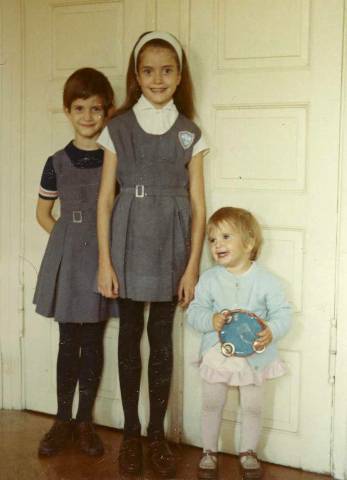 |
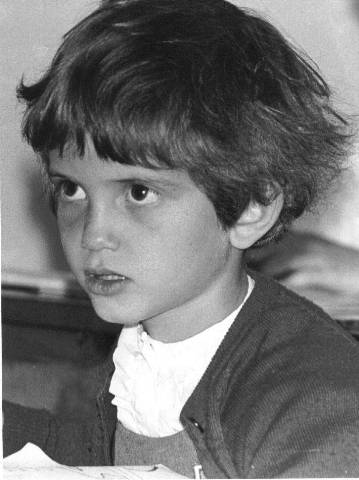 |
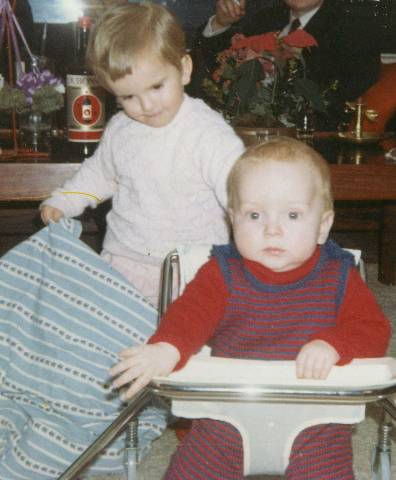 |
Karen and Nicky in their St Josephs school uniforms, Andy with tambourine. Photo of Karen taken at school, Andrea with her younger cousin Tim, Ole and Dorte's first child. |
||
Cubby found a school for Nicky nearly 8 years old and Karen recently turned 6 years. This was Sct Josephs, originally a French School but now teaching in Danish with both nun and lay teachers. The children wore smart grey tunics and white blouses to school. After learning Flemish in Belgium they soon learnt Danish and integrated well into the school - regarded by their fellow large blond Danish pupils as tiny light brown exotic beings. The school was reached by an efficient tram[1] service – initially Cubby accompanied the children to school, but later they were quite confident to do the journeys on their own. The school was on Dag Hammarskjolds Alle[2]. Cubby still had the youngest two children at home all day – unfortunately no neighbourhood school could be found to take 4year old Christopher who was now keen to go school (and would have been able to do so in Belgium). Most Danish families of our children’s generation were carefully restricted in size to two or fewer children. Birth control was obviously rigorously practised. Danes were surprised that we had four children and some obviously disapproved of such parental reckless behaviour. In Catholic Belgium we had always felt that large families were welcome and desired.
Denmark even at this time had a reputation of being a sexually tolerant society, but we did not find the general mass of people to be particularly open minded in other aspects – indeed they appeared to be rather uptight and seemed to be strait jacketed by housing and money in their highly taxed welfare state. Occasionally the Danes seemed to drop their polite guard when having a good meal of smorgasbrod chased down with snaps and beer. It was not uncommon for me to see, when walking to work early in the morning, a street cleaner or building labourer starting his day with beer direct from the bottle.
Cubby brought up in South Africa did not yet speak Danish fluently. Her older sister Bodil had been in Copenhagen since 1958 before her parents return to Denmark in 1962. She was married[3] to Soren Weiss (a stage actor with the Kongelige Teater) and they lived within walking distance in a modern apartment at Droningstvergade. Younger sister Dorte, married to Ole Eisen and baby son Tim lived at Hjortekaer (near Dyrhaven Park) where they made and painted pottery to the designs of Bjorn Wiinblad. Numerous other relatives were also in Copenhagen – matriarch Farmor (Cubby’s father, Aage’s mother) then 75years old and her daughters Elsa and Kisse - Cubby’s aunts. Cubby and I attended separate Danish lessons at night as she was more advanced than me. She had picked up some words from conversations of her parents at home in Danish not intended for children’s ears – usually they had spoken English in South Africa. I did not progress too well - it was too easy to speak English to the Danes with whom I came in contact.
Each day I walked about a mile to the office at Ostedhus on Vester Farimagsgade passing through a series of relaxing immaculately kept public parks, Kongens Have, Botanisk Have, and Osteds Parken. I often returned home walking through Raadhus Pladsen up bustling Stroget the famous and probably first ‘pedestrians only’ shopping street with motorcars banned from general usage. Reaching Kongens Nytorv I then turned home to nearby Sct Annae Plads.
CN’s offices were in Ostedhus in an interesting building with an exposed concrete structure. I worked assisting in the preparation of tenders. Some I recall were harbour works in Kenya and Iceland[4], buttress dams in Thailand - exotic lands we hoped to visit if we were successful. Unfortunately there did not really seem a desire within CN at this time to find and execute foreign projects – possibly the financial risks[5] were considered too great and the profit margins too low. To fill in idle time in the office I wrote up a concrete report covering the work on the Schelde Tunnel elements.
At the offices there were a few faces I knew from Pakistan and Antwerp and also a South African – Ivor married to Bente an attractive Danish woman (we were to meet them again later in Cape Town in mid 1970). However, a companionable atmosphere such as found in London with Arups was lacking. The Engineers came to work exactly on time, busied themselves facing forward in rows of desks overlooked by the Chief Engineer in his glass cubicle at the back. Engineers talked only occasionally about work to one another, other subjects seemed barred. At lunchtime I often took and ate my ‘madpak’ (sandwich pack) in Osted Parken across the way rather than in the dull CN dining room – my lack of ability to communicate in Danish probably made me introverted. At five thirty sharp staff would down pencils and slide rules, and rush away apparently home to domesticity.
On 10th June 1967 shortly after we arrived in Copenhagen the marriage of Princess Margrethe to Count Henri Laborde de Monpezat a French diplomat (later called Prins Hendrik) took place. While Cubby watched the television broadcast of this event at Hjortekaer with sister Dorte, Nicky, Karen and I walked round the corner to Amaliaborg Palace and saw Princess Margrethe accompanied by Kong Frederick IX leaving the palace in a horse drawn carriage on her way to the church. Later Cubby saw the princess and her prince walking past our apartment and thinking their faces looked familiar greeted them to be greeted in return. Princess Magarethe ascended the throne as Queen Margarethe II after the death of her father in 1972.
We drove together with Dorte and Ole to Korsor and caught the ferry to Lohals on the Island of Langeland. Ole’s sister Karin was married to Erling Heerwagen and they were working as potters both for Wiinblad and also on their own original designs. We pitched camp in the large rough field in front of their house and workshop. Unfortunately Christopher developed laryngitis in the damp misty weather overnight and next day early we retreated taking the ferry from Spodsbjerg to Nokshov and driving back to Copenhagen. Ferries in Denmark and also across to Sweden were a pleasant aspect of life breaking ones journey with a good meal of smorgasbrod and beer. Unfortunately with linking bridges for cars and trains and also economic considerations many ferries have now disappeared on several routes – Lohals, now cut off by a direct ferry is even more of a back water and more awkward to reach. Stringent drink driving restrictions also cut down alcohol consumption by car and truck drivers on Ferries.
Lohals was later to become important to us as Dorte and Ole moved there after we had left Denmark gradually taking over Ole’s mother Rita’s small farmhouse Bastemose on the outskirts of Lohals. Rita finally moved to a new bungalow in Lohals. Aage and Mercia also moved there in 1972 when he retired from CN London and built a house while staying initially in a caravan. Lohals effectively became our ‘home’ when we left South Africa in 1980 for a second time and returned to Europe on holiday from projects abroad. On a visit to Lohals in 1998 – over 30 years later when packing up Aage’s / our house, we found that Karin and Erling’s rough ‘camping’ field had been moulded into a very attractive almost Japanese garden decorated with many of their unique pottery works.
We took long walks along the harbour, Langelinie, occasionally with Farmor, aunt Kisse, and our children looking at the boats, yachts and shimmering water. We saw the bronze statue of the Little Mermaid and the fountain of the goddess Geffion with her four sons changed into snorting bulls ploughing the soil from Sweden’s lake Veneren to form the island of Sjaelland on which Copenhagen stands. Here some Russian[6] sailors picked up our blond son Christopher, placed him in front of the fountain and photographed this little ‘Danish’ boy much to our amusement.
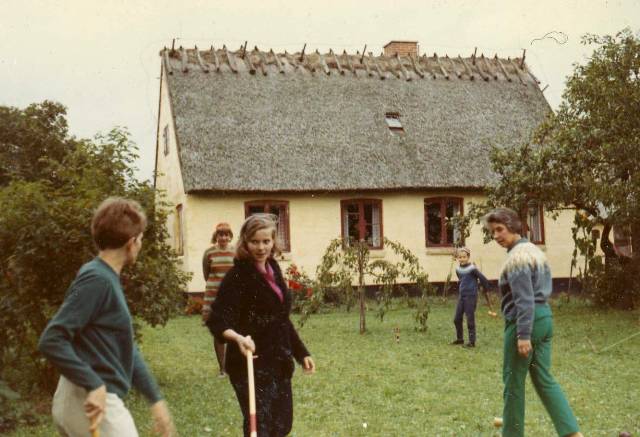 |
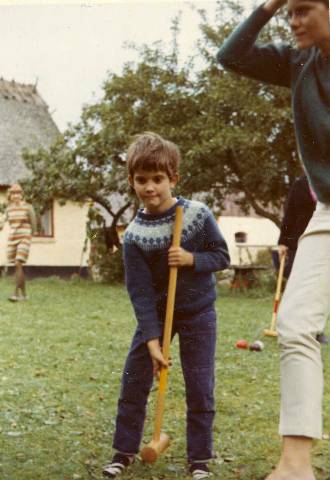 |
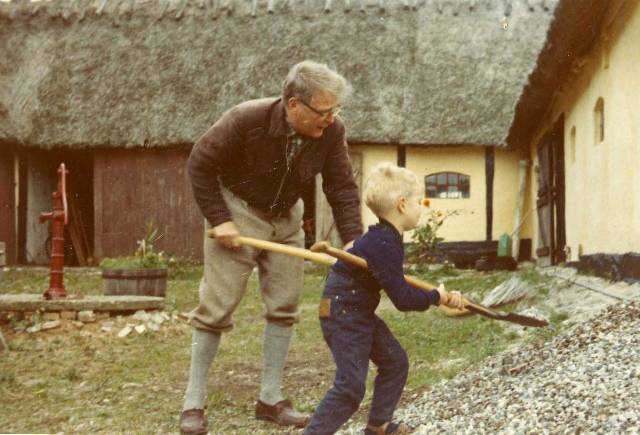 |
Playing Croquet at Cubby's aunt Else and Svens old farm house at Annisse. Cubby, Bodil, Dorte,Nicky and Else in picture on left. Karen in centre picture ready to strike the ball. On left picture Sven and Christopher get down to shoveling stone. |
||
Over weekends we sometimes drove northwest and popped into Cubby’s aunt Elsa’s ancient timber framed country farmhouse at Annisse near Arreso an inland lake. Elsa was sometimes away leading tourist groups in Scandinavia, but her husband Sven (Willert) was often there working in the garden. We would play croquet, at which Karen was particularly adept, while Andrea acted as a movable obstacle making results unpredictable. We picked plentiful strawberries from their garden and carried them home to eat for desert and on breakfast cornflakes in the morning. Unfortunately the farmhouse burnt down later and the Willerts replaced it with a pleasant modern house we visited many years later in1980.
The Willert daughters Mette and Hanne, Cubby’s cousins, were outside Denmark at this time, but we had perchance met their brother Soren while walking in Stroget. Soren, who had journeyed overland via Iran to Pakistan had seen us at Mailsi, now introduced us to his wife Anna and we had them home to dinner.
Not far from Annisse close to Ramlose we saw the start of Knud and Gerda’s retirement house with stunning views overlooking lake Arreso. Gerda was Cubby’s godmother when at 4 years of age she was christened in Durban in 1943 during the Second World War. Knud had been CN Manager in South Africa - one of his projects had been the Steenbras water filtration and purification plant – I was incidentally to work in the same area on the Steenbras (hydro-electric) pumped storage in late 1970.
We also spent happy hours visiting Bodil and Soren’s summerhouse at Ordrup Nes – a funny shaped peninsula with a drooping ‘nose’ on the west coast of Sjaelland away from Copenhagen. Soren’s parrot ‘Jakob’ chattering in his cage on the stoop was of much interest to our children. The sun shone, Andrea sat playing in the clear water on the white sands – life was contented.
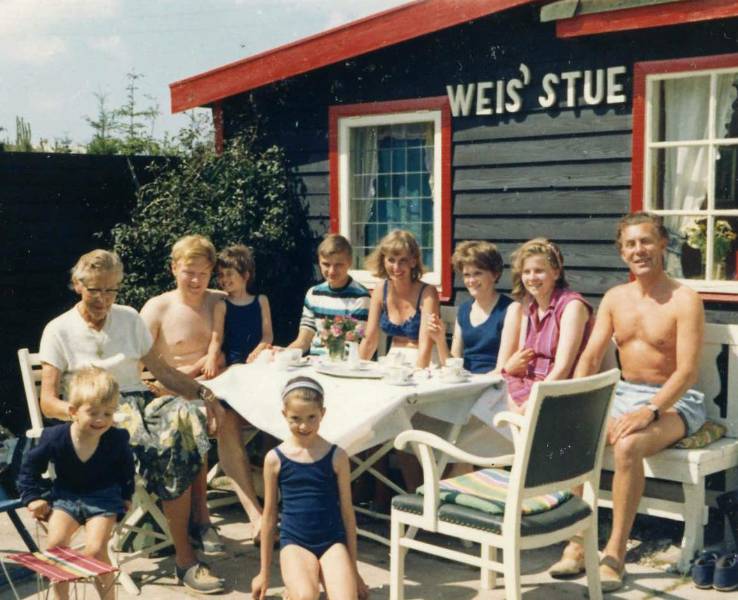 |
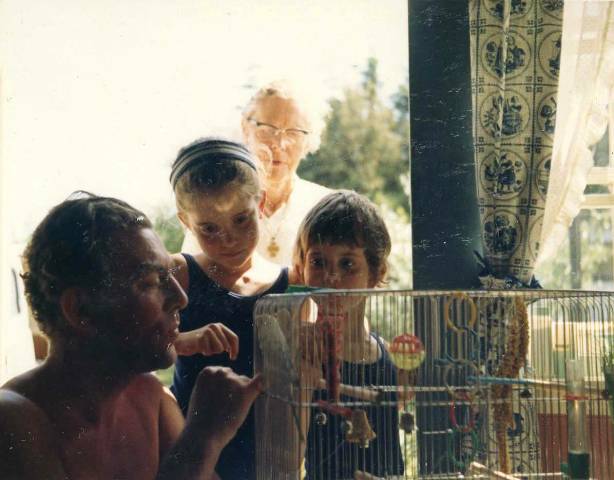 |
Visiting Soren Weiss summer house with three 'Brink' sister on bench with him - Bodil, Cubby and Dorte, on left Mor Weiss, Ole, Karen and another with Christopher and Nicky in front. Children fascinated by Soren's budgie - Mor Weiss behind. |
|
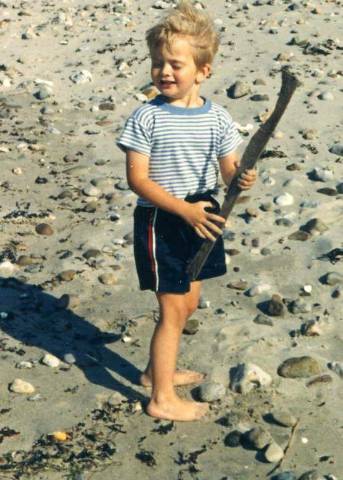 |
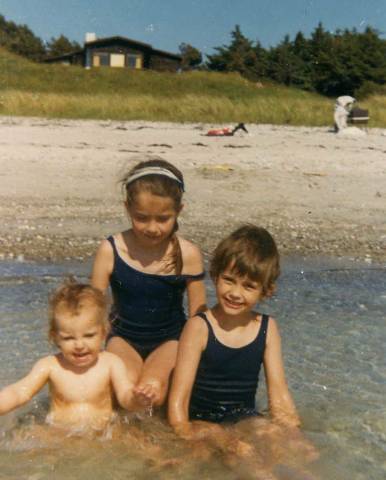 |
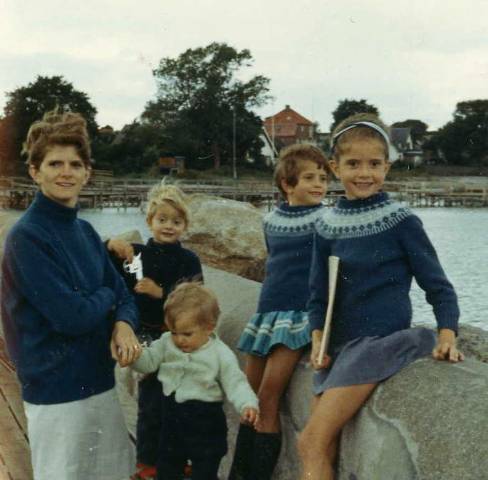 |
In Denmark on Baltic beaches and promenades |
||
We decided to gamble and to take our summer holidays camping in Sweden where we could meet Cubby’s Swedish family rather than rushing southwards to the Mediterranean sun. Just before we left Neville and Margriet and children visited from Antwerp and we handed our apartment to them as a base for their holiday in Denmark. We were rather sad that we could not see more of them.
We took a ferry across to Sweden and switched from driving on the right to the left – Sweden’s change to driving on the right came later. We drove up to Uppsala where Cubby’s (maternal) uncle Manne Bjork and his wife Gunborg lived, After a good filling tea prepared by Gun, Manne in his solid Volvo guided us following four ‘miles’ to a camp site ‘near’ the town. The journey went on and on - Manne had, we found later, been talking of Swedish miles equivalent to ten English miles – already weary we became wearier, but the campsite compensated. We pitched our large blue tent alone on a large grassy pasture on the edge of a translucent brown water lake where we swam - the weather being bright and sunny during our stay. Before the sun came up in the morning or in shady areas, we had to guard against large vicious biting mosquitoes. We in our ignorance were surprised to find mosquitoes in Northern Climes having always associated them with tropical jungles and malaria.
Back in Uppsala we met Manne’s son Lennart and his wife Brigitta and stayed a night at their home enjoying warm baths after our spartan camping. Manne took us for a tour of the Castle and spoke of Linneaus the famous Swedish botanist. We visited the graves of Cubby’s grandparents who had been Swedish missionaries in India. She had only met them once in 1958 when on a holiday for the first time from South Africa to Europe with her parents.
Soren and Anna asked us to visit them for a winter weekend at an old farmhouse in Southern Sweden and gave us careful instructions how to get there. We followed snow clad gravel roads until we stopped as instructed near a cow shed in a wood. All was quiet in the grey moonlit woods, I found a path trodden in the newly fallen snow and followed this leaving the family behind in the car uncertain as to whether this was the right spot. When I was loosing hope I saw a light twinkling as Soren came to meet us. We fetched the family from the car and laden with baggage and four children slithered the ½ kilometre to the farmhouse to be welcomed by Anna. Anna made chicken risotto in the wood fired oven, and we drank red wine and fell soundly to sleep.
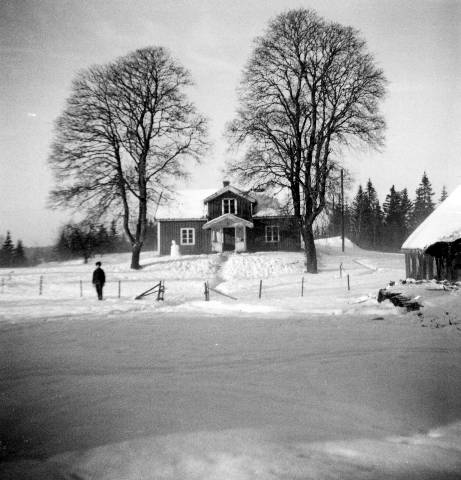 |
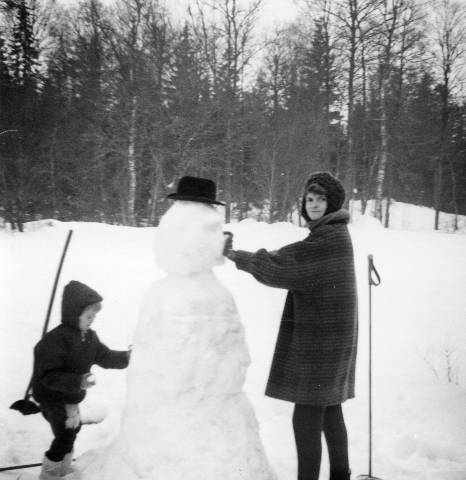 |
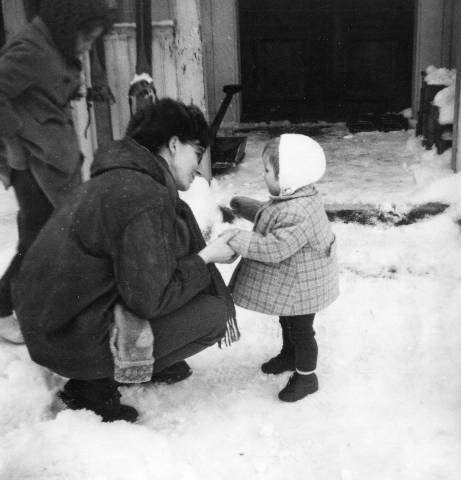 |
In snowy Sweden - Cubby's cousin Soren's holiday house - Cubby and Christopher at snow man. - Anna Soren's wife helps Andrea with gloves |
||
The next day we donned ancient wooden skis left in the house and laboured through the flat surrounding woods – no exciting downhill skiing this but still invigorating. We built a snowman and pelted one another with snowballs.
The toilets were outside the house, built over a little valley with two seats companionably next to one another. Pyramids fortunately frozen solid without smell waited below to be swept away into the woods with the spring thaw.
One day in December 67, walking to work I bought my usual copy of the English Daily Telegraph and found headlines concerning the first ‘successful’ heart transplant operation on Louis Washkansky (who lived 18days after the operation) by the South African Surgeon Dr Christiaan Barnard. The reaction by Danes to this was interesting - they seemed to link this immediately to South Africa’s detested policy of Apartheid. This operation thus took on a political complexion – Barnard seemed to them more a ‘Dracula’ figure rather than a skilful surgeon.
Several staff had been made redundant in the office – some I had known from Pakistan. It seemed realistic to look for a job in a new company, as there did not seem to be any projects coming up. I answered several advertisements in England and went over for interviews, being offered one position dealing largely with concrete technology. CN London, through Cubby’s father, however, made a counter offer on a motorway project which they anticipated obtaining. I accepted this as payment of fares and baggage from Denmark to England was a considerable attraction.
We were to move there at the end of January 1968, but before this celebrated Christmas in Denmark being joined by Cubby’s parents from London for Juleaften[7] – making with Farmor, our children and Dorte and Ole’s Tim four generations.
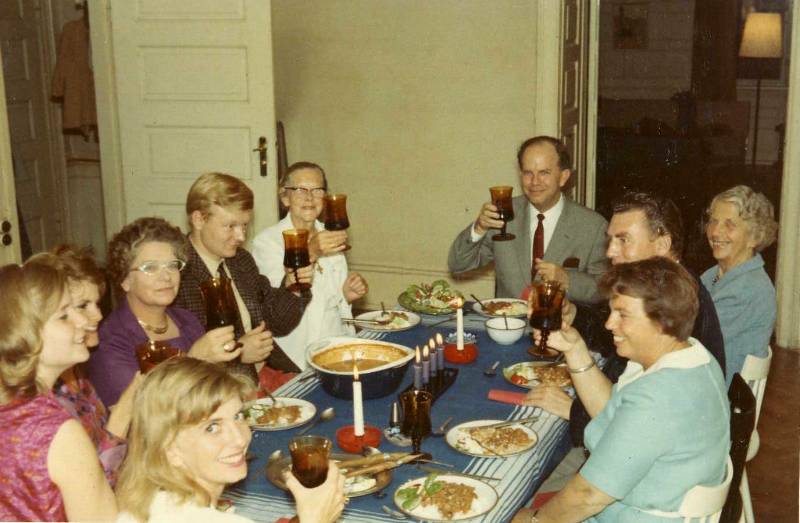 |
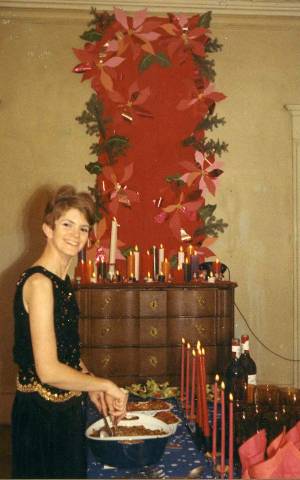 |
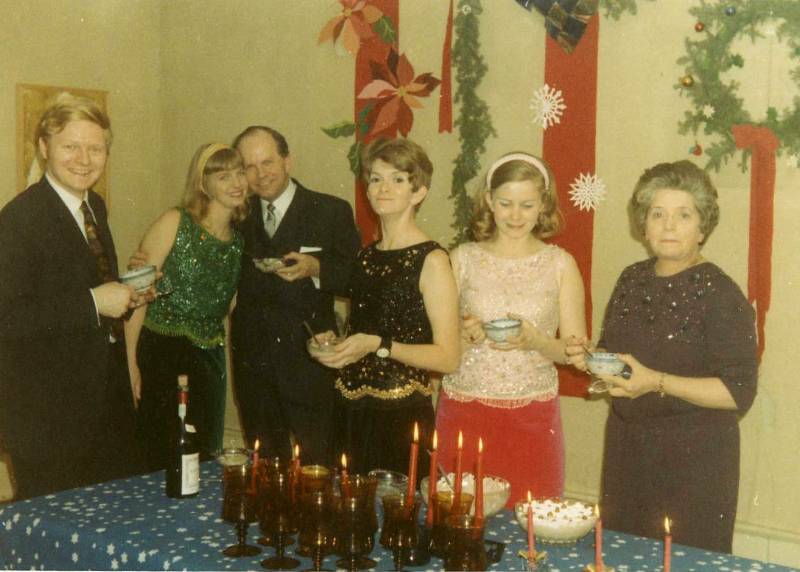 |
At Sanct Annaes Plad's apartment - picture on left - Cubby's father Aage at head of the table with Mor Weiss to left and his mother Farmor to right. His sister Kisse to the right front (see also picture under). Others in picture are Cubby's brothers in law Ole Eisen and Soren Weiss, Cubby's mother Mercia and three sisters - Cubby, Dorte and Bodil. In pictures on right and centre - we celebrate new year 1967 / 68 |
||
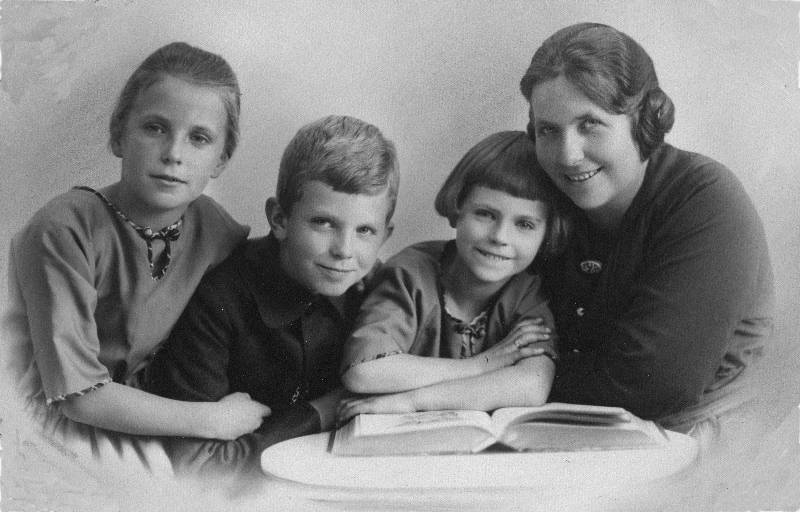 |
An earlier Christmas in 1923 - Cubby father Aage flanked by his sisters Else and Kisse with his mother on the right. |
|
|
Cubby and her grandmother (farmor) in her apartment |
We arranged to leave our old Skoda with steering wheel on the ‘wrong side’ for driving in England with Dorte and Ole. It was in any case now too small for a family with four growing children.
[1] The efficient tram services were unfortunately demolished years later and replaced by diesel buses following a strange European Trend – will trams be re-introduced as elsewhere?
[2] a street was named after the Swedish Secretary General of the United Nations who had been killed in an aircraft crash in 1961 in Ndola in the then Northern Rhodesia (now Zambia). He was trying to broker peace in the newly independent Congo. Later he had been posthumously awarded the Nobel Peace Prize for 1961.
[3] Later divorced – Soren ended up with about 4 wives.
[4] Iceland now an independent State but once a colony of Denmark. The Icelandic language is similar to Danish but they prefer communicating to one another in English to avoid misunderstandings.
[5] Apparently CN was losing money on the huge Guri Dam contract in Venezuela where they were in partnership with a large United States contractor
[6] Later Christopher, possibly subconsciously influenced by this meeting, studied Russian at Manchester University.
[7] Christmas eve celebrations and dinner
index memoir - homepage - contact me at